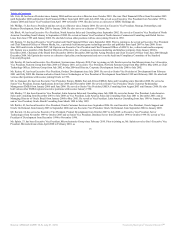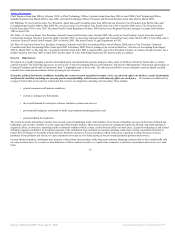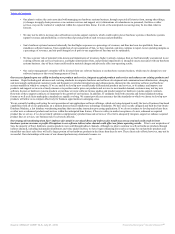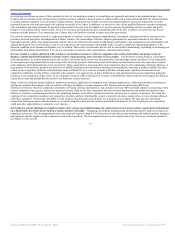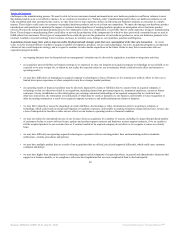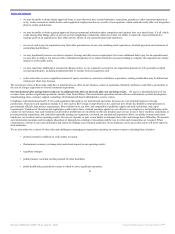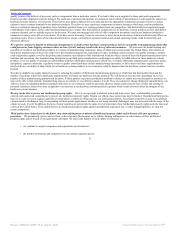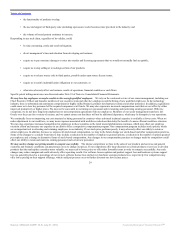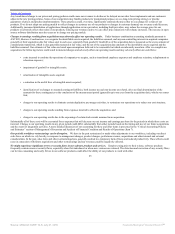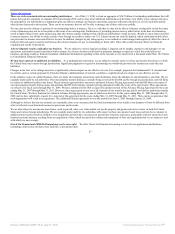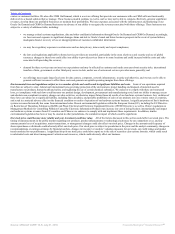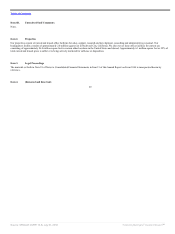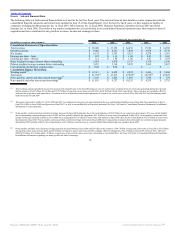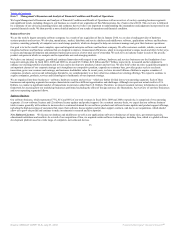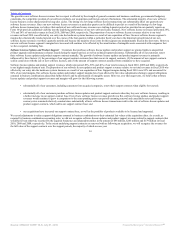Oracle 2009 Annual Report Download - page 28
Download and view the complete annual report
Please find page 28 of the 2009 Oracle annual report below. You can navigate through the pages in the report by either clicking on the pages listed below, or by using the keyword search tool below to find specific information within the annual report.
Table of Contents
• the functionality of products overlap;
• the use and support of third-party code (including open source code) becomes more prevalent in the industry; and
• the volume of issued patents continues to increase.
Responding to any such claim, regardless of its validity, could:
• be time consuming, costly and result in litigation;
• divert management’s time and attention from developing our business;
• require us to pay monetary damages or enter into royalty and licensing agreements that we would not normally find acceptable;
• require us to stop selling or to redesign certain of our products;
• require us to release source code to third parties, possibly under open source license terms;
• require us to satisfy indemnification obligations to our customers; or
• otherwise adversely affect our business, results of operations, financial condition or cash flows.
Specific patent infringement cases are discussed under Note 18 of Notes to Consolidated Financial Statements.
We may lose key employees or may be unable to hire enough qualified employees. We rely on the continued service of our senior management, including our
Chief Executive Officer and founder, members of our executive team and other key employees and the hiring of new qualified employees. In the technology
industry, there is substantial and continuous competition for highly skilled business, product development, technical and other personnel. In addition, acquisitions
could cause us to lose key personnel of the acquired companies or at Oracle. We may also experience increased compensation costs that are not offset by either
improved productivity or higher prices. We may not be successful in recruiting new personnel and in retaining and motivating existing personnel. With rare
exceptions, we do not have long-term employment or non-competition agreements with our employees. Members of our senior management team have left
Oracle over the years for a variety of reasons, and we cannot assure you that there will not be additional departures, which may be disruptive to our operations.
We continually focus on improving our cost structure by hiring personnel in countries where advanced technical expertise is available at lower costs. When we
make adjustments to our workforce, we may incur expenses associated with workforce reductions that delay the benefit of a more efficient workforce structure.
We may also experience increased competition for employees in these countries as the trend toward globalization continues, which may affect our employee
retention efforts and increase our expenses in an effort to offer a competitive compensation program. Our compensation program includes stock options, which
are an important tool in attracting and retaining employees in our industry. If our stock price performs poorly, it may adversely affect our ability to retain or
attract employees. In addition, because we expense all stock-based compensation, we may in the future change our stock-based and other compensation practices.
Some of the changes we consider from time to time include a reduction in the number of employees granted options, a reduction in the number of options granted
per employee and a change to alternative forms of stock-based compensation. Any changes in our compensation practices or changes made by competitors could
affect our ability to retain and motivate existing personnel and recruit new personnel.
We may need to change our pricing models to compete successfully. The intense competition we face in the sales of our products and services and general
economic and business conditions can put pressure on us to change our prices. If our competitors offer deep discounts on certain products or services or develop
products that the marketplace considers more valuable, we may need to lower prices or offer other favorable terms in order to compete successfully. Any such
changes may reduce margins and could adversely affect operating results. Our software license updates and product support fees and hardware systems support
fees are generally priced as a percentage of our net new software license fees and net new hardware systems products fees, respectively. Our competitors may
offer lower pricing on their support offerings, which could put pressure on us to further discount our new license prices.
24
Source: ORACLE CORP, 10-K, July 01, 2010 Powered by Morningstar® Document Research℠



